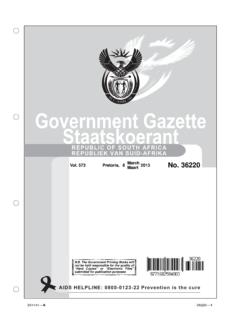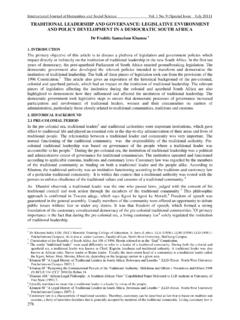Transcription of EXPLANATORY NOTE FOR THE DRAFT …
1 republic OF south africa . EXPLANATORY NOTE FOR THE. DRAFT REGULATIONS ON THE CARBON OFFSET. PUBLISHED IN TERMS OF SECTION 20(b) OF THE DRAFT CARBON TAX BILL, 2015. 20 June 2016. 1. EXPLANATORY NOTE FOR THE DRAFT REGULATIONS ON THE CARBON. OFFSET. ====================. BACKGROUND. Government published the DRAFT Carbon Tax Bill for public comments and further consultation on the 2nd of November 2015. The DRAFT Carbon Tax Bill includes the detailed and revised carbon tax design features as per the Carbon Tax Policy Paper of 2013, announcements in Budget 2014 and the Carbon Offsets Paper of 2014 and takes into account public comments received following extensive stakeholder consultations since 2011. The overarching design of the carbon tax is informed by the administrative feasibility and practicality of covering most greenhouse gas (GHG) emissions and takes into account the need for a long and smooth transition to a low carbon economy in a sustainable manner.
2 The significantly high level of tax-free allowances, recycling of revenues through a reduction in the electricity generation levy and energy efficiency savings tax incentive, and phased approach to the introduction of the tax will ensure that south africa 's competitiveness is not compromised and vulnerable households are protected. The DRAFT Carbon Tax Bill gives effect to the design features of the carbon tax as outlined below, including the carbon offset allowance: An energy combustion tax-free allowance of 60 per cent;. An additional tax-free allowance of 10 per cent for process emissions;. An additional tax-free allowance of 10 per cent for fugitive emissions;. A variable tax-free allowance for trade-exposed sectors (up to a 10 per cent maximum);. A maximum tax-free allowance of 5 per cent for above average performance.
3 A 5 per cent tax-free allowance for companies with a Carbon Budget;. A carbon offset allowance of either 5 per cent or 10 per cent;. The total tax-free allowances during the first phase (up to 2020) can be as high as 95 per cent. This Regulation, which sets out the procedure for claiming the carbon offset allowance and for the use of carbon offsets by taxpayers to reduce their carbon tax liability, is developed in terms of Section 20. (b) of the DRAFT Carbon Tax Bill and is hereby published for public consultation. Policy Rationale for the Carbon Offset Scheme Carbon offsets are investments in specific projects that reduce, avoid or sequester emissions. As defined in the 2014 Carbon Offsets Paper, a carbon offset is an external investment that allows a firm 2. to access GHG mitigation options at a lower cost than investment in its current operations.
4 Under the carbon tax policy framework, firms will be able to reduce their carbon tax liability by using offset credits up to a maximum of 5 or 10 per cent of their total GHG emissions, depending on the sector within which the firm operates. The carbon offset system serves a dual purpose that is as: A flexibility mechanism that will enable industry to deliver least cost mitigation, that is, mitigation at a lower cost to what would be achieved in their own operations, and thereby lower their tax liability; and A way of incentivising mitigation in sectors or activities that are not directly covered by the tax and/or benefiting from other government incentives, especially, transport, Agriculture, Forestry and Other Land Use (AFOLU) and waste. The design of the carbon tax follows the design of carbon pricing schemes internationally that provide for the use of carbon offsets by firms to reduce their carbon tax ability.
5 This includes schemes such as the European Union Emissions Trading Scheme (EU ETS) which allows for the use of offset credits generated by projects approved under the Clean Development Mechanism (CDM), as well as schemes in California and the Canadian Province of Alberta. These carbon offset projects are likely to generate sustainable development benefits and employment opportunities in south africa by encouraging investments in energy efficiency and renewable energy, rural development projects, and initiatives aimed at restoring landscapes, reducing land degradation and biodiversity protection. Eligible standards During the initial stage of the carbon offset scheme, it is envisaged that the scheme will rely primarily on existing international carbon offset standards namely, the CDM, Verified Carbon Standard (VCS).
6 And the Gold Standard (GS) and their associated institutional and market infrastructure. To be accepted under the south African carbon offset scheme, the offset projects will need to be approved by one of these accepted international standards. An allowance will be made to evaluate the robustness of existing domestic standards for eligibility to be used within the carbon offsets scheme. The offset project approval process is specific to each standard. In the case of the CDM, a validation of the offset project by a Designated Operational Entity (DOE) is followed by registration of the project by the CDM Executive Board. Under the VCS standard, a validation/verification body (VVB) validates the project and the VCS Association is responsible for the registration of the project. Under the GS, a DOE validates and the GS registers the project for the compliance market under the CDM while those projects developed for the voluntary market could choose an accredited verification body.
7 The offset project developer is responsible for ensuring this external validation and the registration. 3. This will be complemented by requirements specific to the south African scheme pertaining mainly to additionality criteria and the administration of the scheme whilst drawing extensively on the modalities and rules that govern the international standards. Carbon offset project eligibility criteria In addition, all approved standards, both international and domestic, will also have to meet the south African specific requirements of the carbon offsets scheme. The main eligibility criteria will be: At the initial stage, only projects located in south africa will be eligible under the carbon offset scheme in order to support mitigation in south africa . Projects should occur outside the scope of activities that are subject to the carbon tax to prevent double counting of the carbon emission reduction benefit.
8 The carbon offset scheme will focus on technologies from activities that are not included in the carbon tax liability net, which includes the transport, waste and AFOLU sector activities. Administration of the scheme To facilitate the development of carbon offset projects and a credible carbon offset scheme, appropriate technical infrastructure is required such as a programme administrator; carbon offsets registry; and possible third party verification by accredited third party verifiers identified in the Carbon Offsets Paper. The Designated National Authority (DNA), within the Department of Energy (DoE) which was established to support the development and implementation of CDM projects under the Kyoto Protocol of the United Nations Framework Convention on Climate Change (UNFCCC), will be responsible for administering the carbon offset scheme.
9 Currently, a project is being undertaken by the DoE to assist with the implementation of the administrative framework for the carbon offset scheme. The main output from the project includes setup of a framework for administering the carbon offsets scheme which includes an initial assessment of the capacity and skills requirements to enhance the human resource capacity of the DNA, the development of a Standards and Operating Procedure Manual for administering the carbon offset scheme and a preliminary design of the administration IT system. south africa is also a participant in the Partnership for Market Readiness (PMR) project, administered by the World Bank, which provides technical assistance to countries to support the implementation of carbon pricing policies. Building on the current project by the DoE, further technical work will be undertaken through the PMR to assist with the establishment of the carbon offset system.
10 This 4. includes options for the establishment of a registry; capacity building through further training and secondment of international experts; and compilation of a technical guideline for project developers. PART I: DEFINITIONS. Definitions: Regulation 1. This section provides an explanation of the main definitions that inform the establishment of the carbon offset mechanism. Administrator means the Designated National Authority within the Department of Energy appointed in terms of regulation 5. An emissions offsets means an (external) investment through which a firm can access additional GHG mitigation options that are cheaper than what can be achieved by investment in its own operations. Emissions offsets are project-based that is, involve specific projects or activities that reduce, avoid, or sequester emissions, and are developed and evaluated under specific methodologies and standards.















